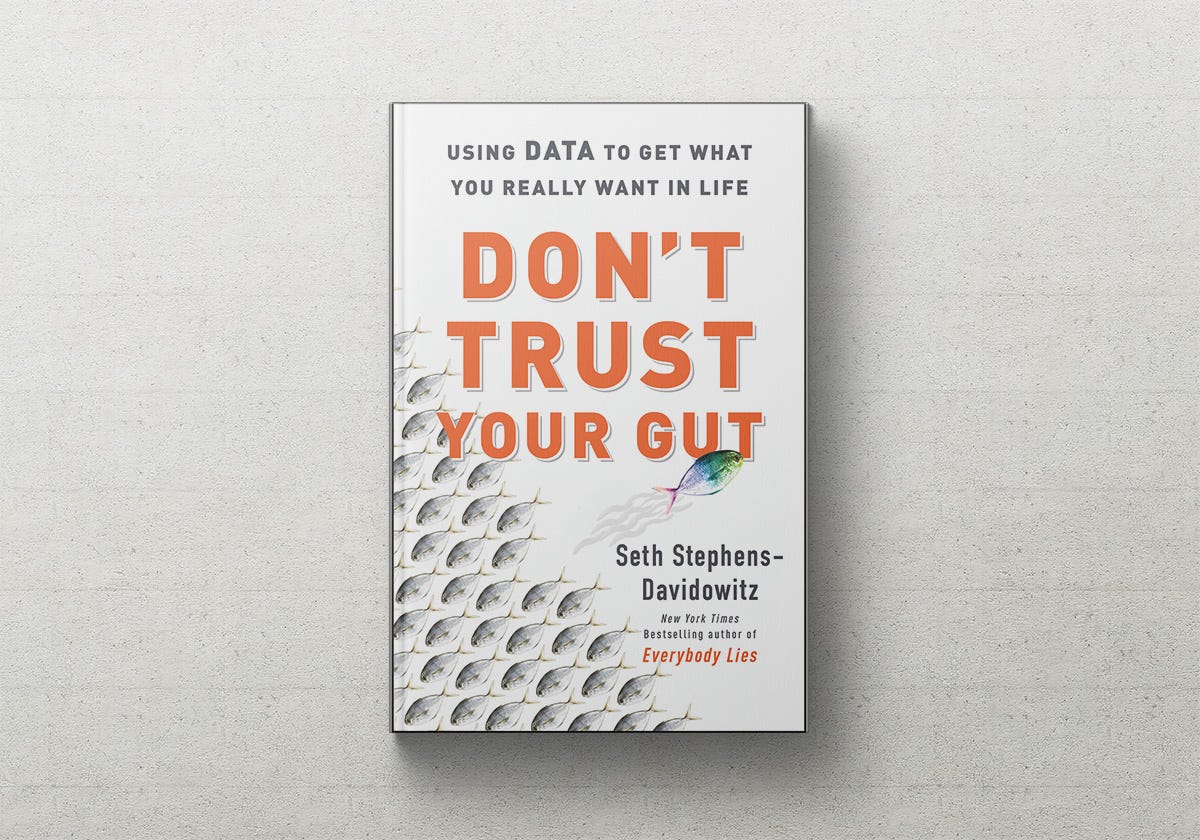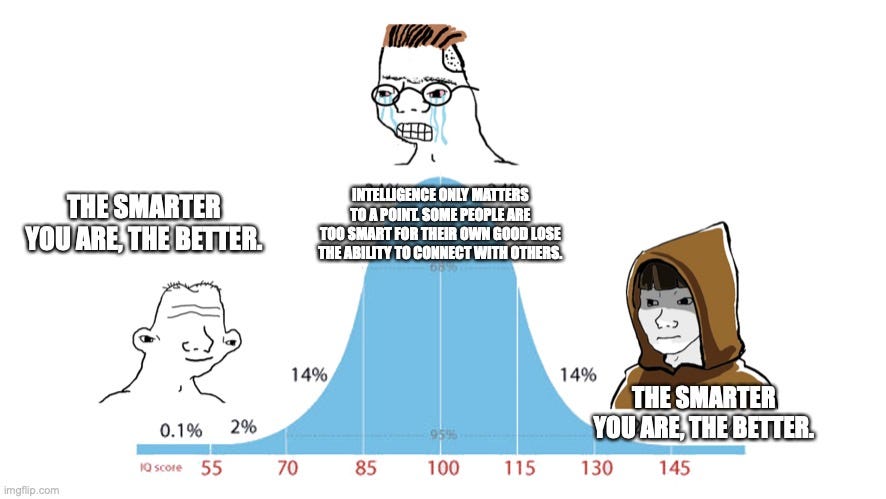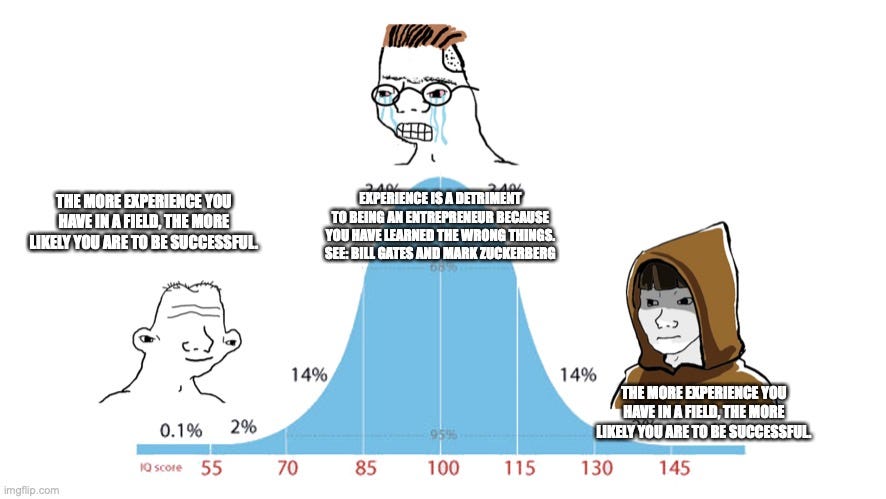Hi everyone,
A few weeks ago, I offered some of my thoughts about Seth Stephens-Davidowitz’s new book, Don't Trust Your Gut: Using Data to Get What You Really Want in Life. In that post, I focused on Stephens-Davidowitz’s insights around dating, relationships, and raising children; in particular, I tried to demonstrate the risks of “following the data” too far when it goes against your initial intuition.
Today’s post includes the second half of my comments about Don’t Trust Your Gut. This time I will start with Stephens-Davidowitz’s interpretations of research into careers, entrepreneurship, appearance, and happiness. From there, I’ll use the process to explore the importance of diminishing returns and the dangers of over-reliance on short-term feedback.
—Edward
This Week’s Sponsor
Turn Your Website Into an Instant Live Show
Live selling is the most effective marketing channel for ecommerce companies today and Reactive is the best way to bring it to your Shopify website. Its interactive features offer engaging customer experiences to dramatically increase sales and AOV. Designed to create successful launches, drops and promotions, Reactive instantly turns your site into a live shopping channel.
Reactive creates unique online events that customers want to experience and brands want to produce. Just 90 seconds to launch your first live show!
Counter-counter intuition
The chapters of Don’t Trust Your Gut that cover relationships and raising children can be summarized by this idea: “what you think matters, doesn’t.” Stephens-Davidowitz claims that most of the things people look for in a romantic partner don’t matter for happiness, and that parenting choices make limited difference in how children will turn out as adults.
The sections of Don’t Trust Your Gut that describe careers and happiness arrive at far more intuitive conclusions. In order to make these data-backed outcomes seem more interesting, Stephens-Davidowitz often interprets them as counter-counter-intuitive findings.
The way Stephens-Davidowitz interprets some of the research reminds me of the “midwit meme” that’s been floating around the internet for the last decade.
Here’s a rundown of how some sections from Don’t Trust Your Gut map onto that meme:
Throughout Don’t Trust Your Gut, Stephens-Davidowitz highlights some fascinating research projects. Even if I don’t always agree with Stephens-Davidowitz’s interpretations, he raises some interesting questions — and data points — about how you can further your career, build your start-up, and improve your overall happiness.
So, how do I think we should interpret the findings?
Careers
If you read Part 1 of my review, you will remember that the book’s major conclusion for ensuring your children become successful is by “moving to the opportunity.”
The advice for careers is very similar. The data indicates that immigrants — despite common disadvantages like language barriers and lack of a local network — tend to achieve better career outcomes than people born in America. The possible explanation: immigrants are far more likely to move to areas of the country with ample opportunity. When you don’t have friends and family holding you to a certain part of the US, why not move to the region where you are most likely to become successful?
Don’t Trust Your Gut includes a particularly surprising fact: about 1% of people who work full time as “artists” rank among the top 1% of national income. Based on this fact, Stephens-Davidowitz makes the claim that succeeding as an artist, while difficult, is not as long a shot as most parents of want-to-be artists would believe. I think his case is overstated due to selection effect — the least successful artists don’t stay working as full-time artists very long before they become part-time artists and full-time workers in another field.
Stephens-Davidowitz continues with an interesting perspective; he attempts to reverse engineer WHY some artists are more successful than others. The answer, like raising children and immigrant success, comes down to geography.
By looking at WHERE artists displayed their art early in their careers, Stephens-Davidowitz found that artists who eventually became successful were far more likely to have exhibited their artwork in more venues across a wider territory. Effectively, every time an artist displays their work in a specific location, there is only a small percent chance they will “catch a break.” If an artist continues to display in the same locations over and over, they simply have fewer rolls of the dice.
Stephens-Davidowitz takes this core idea and applies it to careers, dating, and life in general. Every time you attend a networking event or travel to a conference or go on a date, there is a small chance that your life will be dramatically changed for the better. Most of the time nothing happens, but every encounter generates more rolls of the dice.
The basic advice of “put yourself out there” is not especially insightful, but the more specific strategy of “put yourself out there in different places” is not something most people do. Why not? Two reasons: (1) they simply don’t think of it, and (2) it’s a lot harder and more uncomfortable. For an up-and-coming musician, playing a weekly gig for a friendly audience at the neighbourhood pub is much easier to bear than driving to multiple cities and performing for apathetic crowds in unfamiliar venues. In the corporate world, it’s much easier to return to the same annual conferences and trade shows than registering for new events, navigating different programs, and socializing with strangers.
In marketing, this concept is familiar: reach is far more important than frequency.
You can also apply this idea to relationships; if you keep dating the same type of person, then you will continue experiencing the same kinds of problems.
Ultimately, the concept of “put yourself out there in different places” means that you should get more uncomfortable with short-term negative feedback, in order to maximize your long-term success.
Which brings us to happiness…
Happiness Activity Chart
A large section of Don’t Trust Your Gut explains what makes people happy. In particular, Stephens-Davidowitz refers to a massive research project led by George MacKerron (University of Sussex) and Susana Mourato (London School of Economics).
[The researchers] created an app, Mappiness, recruited users, and pinged these users [on their smartphones] at different points of the day to ask them some simple questions. The questions included:
What are you doing? (Users could select from forty activities, everything from “Shopping/errands” to “Reading” to “Smoking” to “Cooking/Preparing Food.”)
Who are you with?
How happy do you feel, on a scale of 1 to 100?
After some years, the Mappiness team had built a dataset that contained more than 3 million happiness measures from more than 60,000 people.
In addition, the researchers were able to track WHERE the volunteers were located at the time of the random phone notification.
Following the project, the researchers produced a detailed index that listed the impact of various activities, people, and places on individual happiness.
Here are some of the highlights from the “Happiness Activity Chart”:
Highest reported happiness activities (gain in happiness relative to not doing activity):
Intimacy/Making Love (14.2)
Theater/Dance/Concert (9.29)
Exhibition/Museum/Library (8.77)
Sports/Running/Exercise (8.12)
Gardening (7.83)
Lowest reported happiness activities (gain in happiness relative to not doing activity):
Sick in bed (-20.4)
Working/Studying (-5.43)
Care or Helping for Adults (-4.3)
Waiting/Queuing (-3.51)
Admin/Finance/Organizing (-2.45)
Impact of people on happiness (gain in happiness from being with them, relative to being alone):
Romantic partner (4.51)
Friends (4.38)
Other family members (0.75)
Clients, customers (0.43)
Children (0.27)
Colleagues, classmates (-0.29)
Other people participant knows (-0.83)
Impact of location on happiness (gain in happiness compared to being in an urban environment)
Near a large body of water (6.02)
Mountains (2.71)
Woods (2.12)
Grasslands (2.04)
Farm (2.03)
Wetlands (1.8)
Suburban (0.88)
Understanding happiness
In addition to the project that produced the Happiness Activity Chart, Stephens-Davidowitz references other happiness-focused research findings.
One clear conclusion: having higher income makes you happy, but there are diminishing returns. Each doubling of income only leads to a linear increase in happiness.
Here’s a more complicated conclusion: adding alcohol to any given activity increases perceived happiness. The “booze boost” is largest for low baseline happiness activities (like traveling, queuing, or cleaning) and smallest for activities that are high on the happiness scale (like having sex, dancing, or socializing with friends). From these points, Stephens-Davidowitz suggests that we would be happier if we stopped drinking at parties and started drinking while getting ready for parties, traveling to parties, or cleaning up after parties. I think if you are going to interpret the data that way, then your best strategy would be to drink all the time (or at least as much as you can until the hangovers cause a net decrease in happiness). The data-driven conclusion is that alcoholics were right all along.
There are other conclusions that come from this type of interpretation:
Children don’t make you happy
Spending time with non-close friends makes you pretty unhappy
Working makes you unhappy
Watching TV, surfing the internet, and sleeping don’t make you happy
Being outside in nature, near a large body of water, away from the city makes you happy
There are a few issues with these conclusions. While there are diminishing returns from earning higher incomes, the additional money allows people to do more activities that make them happy. Income also leads to more stable relationships, which increases personal happiness. We know from earlier chapters that one of the best ways to build a successful career is by spending time with strangers — to put yourself out there. I expect that spending time “working” is also an important ingredient to developing a successful career and increasing your income.
And yet, working seems to make people unhappy. As does spending time with strangers.
Stable relationships lead to higher levels of happiness and many stable relationships lead to having children — but spending time with children does not bring as much happiness as being alone with your romantic partner.
Stephens-Davidowitz concludes that the happiness data tells us we should spend more time outdoors with our friends. Without question, the data does indicate that people enjoy being in nature and socializing with friends.
But a strict interpretation of the data suggests that an even higher level of happiness could be achieved if we avoid having kids, never cook at home, and minimize the time we spend working. Instead, we should spend all our time dancing, having sex, and drinking vodka. That sounds like a fun night, but not such a fun life.
I see a problem with the data used in some of these studies. They measure a specific type of happiness — a short-term, immediate, “comfort-type” happiness, but they ignore the long-term, overall-life-satisfaction type of happiness. When the proverbial deathbed happiness optimizer looks back on their life, I doubt they’ll wish they had spent more time drinking and dancing.
Feeling satisfied with life seems far more dependent on building things:
Having a family, and raising happy, healthy, and successful children
Pursuing a meaningful career and making a real impact on the world
Meeting new people and building long-lasting relationships
Exploring new places in the world and experiencing everything life has to offer
I would trade a night with a beer in my hand for more time doing any of those things — and I think that is true for most people. And yet, all of those things (kids, working, travel) landed near the very bottom of the Happiness Activity Chart.
Part of the problem may just be the limits of vocabulary. In the English language, the word “happy” means both (1) the visceral ecstasy that comes from a specific moment of pleasure, and (2) the enduring bliss that results from a sustained period of joyfulness. These happiness studies do a good job at measuring the first definition, but is that the definition most people want to spend their life optimizing for? And if so, isn’t the easiest way to use even more enjoyment-enhancing drugs? Why stop at alcohol when you just want to stimulate your dopamine centers?
Diminishing returns of happiness
Even if we just concern ourselves with the “specific moment of pleasure” type of happiness, I suspect there is a second problem with Stephens-Davidowitz’s interpretation of the data. He points out that we spend far more time doing things on the Happiness Activity Chart that do NOT make us happy than things that seem to make us very happy. Why do we spend so much time watching TV (2.56) and sleeping (1.08), when we could be using that time to garden (7.83) or birdwatch (6.28)? Stephens-Davidowitz thinks that people have their priorities messed up, and just don’t understand themselves very well. I think he is forgetting about diminishing returns.
A friend of mine read the happiness chapter and was shocked at how low people scored spending time with their children. From his perspective, the time he spends with his kid is the highlight of his day — he can’t even think of something that comes close to making him that happy. Why don’t other people feel the same way? Here’s the reason: he has a busy job and a full-time nanny. On an average day, the nanny deals with the temper tantrums, the mealtime fussiness, and the bedtime delays. My friend gets to spend an awesome hour playing with his kid! That’s great for my friend. But it’s not representative of most people who filled out the survey. If you spend one hour with your kid every day, it’s almost always going to be an amazing experience. It’s the fifth hour when parenting gets hard. The fifth hour when you want to be doing something else, but you can’t. No matter how much you love playing with your kids, each extra hour will produce diminishing returns of happiness.
If we look again at the list of activities that make people happy, it becomes clear they are all activities that we don’t do very often or for very long durations. Even the most nymphomaniac of the survey respondents were only spending a tiny fraction of their day having sex. Many of us love going to see live theatre (9.29), but those outings are usually reserved as a special treat. The infrequency is a key factor in leading to our increased happiness. If people went to the theatre more often — or ended up somehow watching theatre for six hours a day — I expect the happiness impact of that activity would drop considerably (maybe to something like 2.55 — the boost in happiness that we get from watching TV).
All of the top-scoring things on the Happiness Activity Chart are like this. Maybe walking in nature makes us happy, but that is because most of us don’t spend very much time walking in nature. Start walking in nature from 9-5 on Monday to Friday, and I’ll bet it starts to feel like a job (happiness -5.43).
The study also explored the impact of various working situations on our happiness:
Working from home (3.59)
Working while listening to music (3.94)
Working with your friends (6.25)
Stephens-Davidowitz treats these insights as a guide not just for individuals, but for employers wanting to maintain their top talent — let them work from home, and maybe even try to hire their friends.
It’s possible that the data is correct: working from home, to music, or with friends increases people’s happiness. But it’s also possible that those factors are all responsible for reducing the total number of work hours that employees spend actually working. (Remember that working (-5.43) is the second-lowest-rated activity, so any decrease in the number of working hours is apt to produce happiness).
Ultimately, most of these research questions about happiness boil down to this one: “why doesn’t income increase happiness more?” Diminishing returns is the obvious explanation — an extra $100 when you are living on one dollar per day is life changing. If Jeff Bezos is gifted an additional $100, he would never even know.
Perhaps, though, here’s another part of the reason why income doesn’t increase happiness more: the characteristics it takes to become rich (hard working, delaying gratification) are the same characteristics that would prevent someone from “maximizing their happiness” by spending every single moment having sex, near a large body of water, while drinking alcohol.
I recall a tweet where a journalist wrote something like, “If I were a billionaire, I would just get an amazing beach house and relax for the rest of my life” — to which a person retorted with something like, “And this is why you did not become a billionaire.”
Maybe Jeff Bezos is not happier and more satisfied with his life than a random survey respondent who lives by a lake, but to butcher Bezos’s popular quote about anecdotes and data: “The thing I have noticed is when long-term life satisfaction choices and the short-term happiness data disagree, the long-term life satisfaction is usually the right choice. There’s something wrong with the way you are measuring it.”
Keep it simple,
Edward
PS — I would be remiss not to mention that Don’t Trust Your Gut also recommends that parents register their children in sports with the lowest genetic component to success. Quite obviously, don’t bet on your short kid becoming a great basketball player. But Stephens-Davidowitz takes things one step further by listing the relative genetic component of two dozen sports. My takeaway: I should get my gymnastics-interested daughter to try diving instead. The way he figures out the genetic component of each sport is pretty ingenious, and I feel bad I couldn’t find a way to cover that material in either of my reviews.
PPS — Stephens-Davidowitz also posted a handy link to review a lot of the data referenced in the book.
Edward Nevraumont is a Senior Advisor with Warburg Pincus. The former CMO of General Assembly and A Place for Mom, Edward previously worked at Expedia and McKinsey & Company. For more information, check out Marketing BS.












Agree with mostly everything, and you somehow managed to critique almost all parts of the book while remaining complimentary to the author.
Not sure I agree with you that most people would be happier engaging in more family-oriented and long-termist endeavours. My experience growing up around normal (not middle-class) people is that they are either unable or unwilling to take the long view in most situations, and that short-term pleasures can be the only things that can bring any joy to their lives at all. The worst part is, this is probably rational for large swathes of the population. Most people simply aren't gonna have great career because some combination of their cognitive toolkit and temperament won't allow it.
Relatedly, while the long-termists are definitely more successful in almost every endeavour I'm not sure they are happier. Now, you're more successful than me and have had a much longer career so I'm willing to take your word for it. Can only say my experience with the kinds of people who put in the extra hours, make efforts to build and learn new things, meet new people, and make time for their kids is that very little of it makes them happy in the long or short term. They don't even have time to feel happy about it because they are too hung-up on failing at this one small thing, or because some goal hasn't been reached yet. Maybe this retrospective satisfaction kicks in after retirement(?), but not sure it passes any kind of utilitarian calculus over the lifecourse-even if we weight delayed gratification-type utility much higher than everything else.
Don't get me wrong, I still think these people are 'happy', just in some masochistic Sisyphean type of way.
I believe the data for immigrants also misses one key component of growth mindset: Post Traumatic Stress Growth. Or, Post Traumatic Growth (PTG for short).
Many immigrants came from traumatized pasts. (I have a few refugee friends from Eritrea and you should hear their horrible stories and what it took to get here - crossing the border into Ethiopia with the risk of death). And when we have trauma we can go through PTSD or PTG - they are opposites but both caused by trauma. The difference in outcomes is usually swayed by attitude- which anyone migrating to the USA for a a better life probably has an optimistic attitude. Well if these immigrants experience PTG that is a massive motivator for positive growth, and explains their excellent outcomes. Jane McGongical talks about PTG in this Ted Talk. I also experienced it.
https://youtu.be/lfBpsV1Hwqs